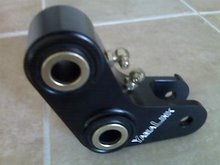Lowering links are not recommended for really big jumpers or ditch bashers or freestyle guys. Due to the increased leverage, it makes the bike more plush but that means it blows through the travel easier. We've had great results with aggressive riders turning in the high speed compression about 1/8 turn and going in on the rebound at least one click. The forks are raised about 6mm.
One misconception is that you must have a 1:1 ratio of fork and rear suspension lowering. Not true. Changes to rake/trail affect geometry at a different rate than changes to rear suspension. The best handling bikes we've been on are lowered in the rear about 1/4 to 1/2 inch more than the front.
Another misconception is that you lose travel. With a link that has an increase in leverage, you actually gain travel because the rear wheel can go up further into the rear fender. This also means you may hit the rear fender with the wheel. Some riders scream bloody murder "my rear tire is hitting the fender....I bottomed so bad" Of course. More leverage. But look at any expert/pro mx or off-road racer's rear fender = big black marks! Not just cuz they are hitting big triples, but because most of them run one-off linkages.
Lowering links are not for everyone. We classify these as "lowering links" and not performance links. Yes, 250 two stroke racers use our 1.75 inch link because on their bikes it gives them 1 inch lowering but they change the sag to about 1/2 less than factory spec, and it makes their bikes ultra smoother on the choppy tundra/braking bumps/accelerations bumps. They're not necessarily going for lowering. They're going for increased leverage to get the teeth rattling bumps smoothed out (but you have to change sag or you'll truly blow through travel easier).
Trailer riders. Short people. Weekend warriors. All looove our YamaLink.

No comments:
Post a Comment